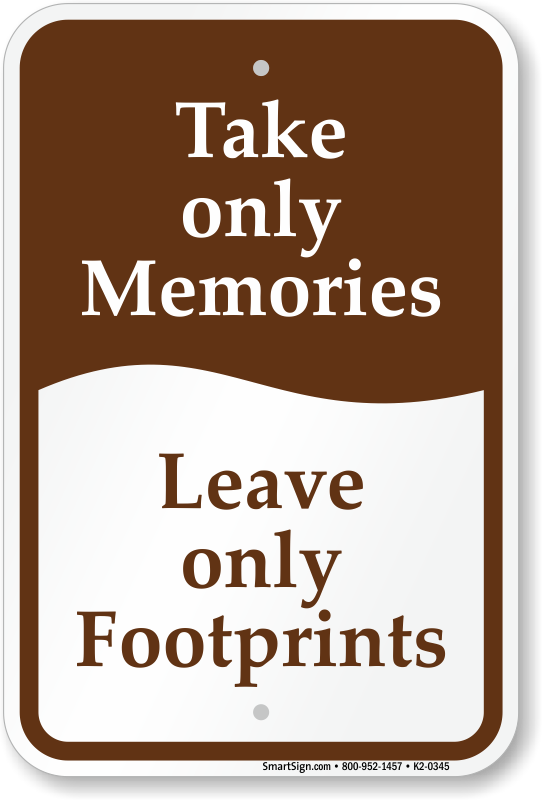Digital Tattoos
 |
| Image source - Campgorundsigns.com |
If you are fond of travelling and experiences in nature as I am, odds are you have encountered something like this sign. And while it is good advice in natural settings, it's basically impossible in digital ones. Outside, the idea is that footprints will fade, become covered up or wash away over time. Online, however, we need to consider our footprints more like being placed in wet cement. This is the idea of our digital tattoo: what we post online never truly leaves.
Data Mining Myself
This week I explored my own digital tattoo by performing some data mining. I used several resources to try to dig up as much information on myself as I could, paying special attention to look for photos or things I didn't think should be in the public record. My feeling going in was that I would not have much in the way of a digital tattoo. While my feeling was basically confirmed, there were some interesting discoveries along the way.
Tools Used
In order to find this information, I used the following websites:
I used only free portions of any sites that asked for payment.
What I Found
 |
| My personal Twitter profile image. Source - personal image |
First, I searched for my personal (@DomPizzuto) and new professional (@DomsEdTech) twitter handles, which are the only two social media accounts I have. I was able to find my personal profile pic (bonus points if you know what it is) and links to this blog and a couple of tweets, but everything else was unrelated to me. This is pretty much what I expected since I don't maintain much of a digital presence. Interestingly, I did find a different person using Instagram with the same handle I use for Twitter. I'm sure he is a wonderful young man, but it's probably best we do not look alike as neither his digital tattoo nor literal physical tattoo are what I would choose to represent me!
Next, I searched for my name and address in the above sites. In some cases, I was able to find some pretty accurate information about me, which was not surprising as I know that it is all a matter of public record. The only thing that I don't understand is the Pittsburgh, PA listing; neither I nor my family lived there.
 |
| Image source - screenshot of data mining from InstantCheckmate |
Other sites had less accurate information including places of employment I never worked at or listing me as 66 years old. On BlockShopper, I found quite a bit of information about the sales history of my home, as well as the address, coordinates and a google map of where I live. I wasn't sure if substitute teacher salaries were public record so I checked the Illinois Public Salary Database; I was not listed. I was able to find my wife's information though, and it appeared mostly accurate given its age.
Reflections & Takeaways
Overall I was satisfied with the information I found about myself, and not surprised by the relatively small amount of data out there on me given my personal web presence at this time. Most of the information was aggregated from the public record with small additions from social media.
I do think this activity would be beneficial to perform with students, especially given how much of their lives are out there in social media all the time. I know I could make a lesson for my transition students, but I think it would probably be an interesting exercise in middle school that could be performed with the library media specialist or a classroom teacher, depending on the comfort level with technology.
I didn't turn up much on myself either! I think being Gen Xers we have less of a presence in the digital world. I also think that coming to these social media sites later in life, we had learned so be more judicious with our sharing anyway. My daughter, who is 24, already laughs about the things she posted when she was 15 or 16. I thought about testing out the Data Mining on my own kids to see if more information turned up and conversely my parents too, who may have very little out there. In some cases it may be better to not know. I agree that this might be a good exercise for middle school or high school students.
ReplyDeleteThanks for the reflective post!
ReplyDelete